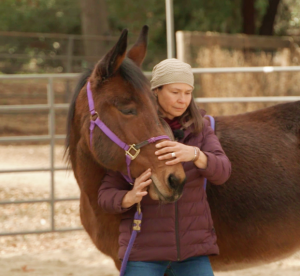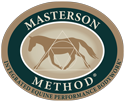by Loni Langdon
 Here’s something I really want to put out to the world…there’s nothing like The Masterson Method® of Integrated Equine Performance Bodywork and a good mule!
Here’s something I really want to put out to the world…there’s nothing like The Masterson Method® of Integrated Equine Performance Bodywork and a good mule!
If you have mules in your life, understanding a few of The Masterson Method® foundational principles can really be a game changer. Having a goal of improving performance, refining communication and/or deepening your relationship with your mule is so attainable.
When I first started working with mules in 2005 my knowledge and understanding of mules was limited. Although I had been around horses a great deal of my life and ridden a lot, I learned quickly that mules were different. I sensed there was something missing from my horsemanship experiences that left me unequipped to work with these long-ear equines. Sadly, I made many mistakes with my hoofed co-workers simply because I did not understand how they communicated via their body language. But I was determined to learn from my mistakes and from the mules in my care.
Finding out about The Masterson Method®
 Luckily I came across Jim’s book, Beyond Horse Massage. When I started trying the techniques with the pack mules some foundational principles really made my work easier. This allowed me to develop a new way of communicating and working with them.
Luckily I came across Jim’s book, Beyond Horse Massage. When I started trying the techniques with the pack mules some foundational principles really made my work easier. This allowed me to develop a new way of communicating and working with them.
Jim’s texts hold many universal equine truths that anyone can learn and use to be more successful with mules. Here are a couple of excerpts from his book with some additional mule specific “A-Ha!” notes that may support you:
“The horse’s instinctive survival response is to brace against intrusion, discomfort or pain. If you bypass this bracing response by softening, you can get the equine to release tension.”
Here’s a generalization about the nature of horses, donkeys and mules: if a horse’s first instinct is to flee, a donkey’s is to freeze or fight. A mule’s response lands somewhere between… at any given moment.
A mule can brace all day long! Often, the more pressure they feel and discomfort they sense, the more they will brace. This makes them more difficult to work with. Innate donkey-fighting-wisdom passed down from Daddy tells a mule to brace, resist or fight. If a mule can brace long enough and hard enough we will give up sooner than they will. Ask yourself if you are being an intrusion, discomfort or pain in the ass? Sorry, I couldn’t help myself there.
“The Principle of Non-Resistance: Whenever you encounter resistance in the horse, if you soften or yield to that resistance it will allow the horse to release pain or tension behind that resistance. When a horse is bracing against you, he can’t release.”
The Principle of Non-Resistance is about feel: communicating through movement, sensitivity, timing and harmony. Feel is something that’s really hard to describe and even more elusive to learn and teach. Yet this idea of yielding to pressure, first within ourselves, seems so counter-intuitive but is incredibly powerful in our interactions with mules. If you are braced, the mule will be too. Simply, your tension becomes theirs. If the goal with bodywork is to help the equine feel more comfortable and to help them reduce pain, we have to offer comfort as well as the opportunity to follow a softening feel.
Where to start with a mule?
Here’s a starting place. Learn the Bladder Meridian Technique. It is something that is so easy to do, takes just a few minutes to practice and can really help soften a skeptical long-ear.
With the Bladder Meridian Technique and many of the other Masterson Method® techniques, we work in the space called Air-Gap or Egg Yolk. It is a very gentle, soft amount of touch. Air-Gap can command a wide berth or it can be effective by just barely making contact with one hair. By being sensitive to where this invisible line is (I call it a bubble), it allows us to work under the mule’s instinctive brace response. When you recognize where a mule’s bubble is, soften a little in yourself because it’s like saying to them that you recognize and respect where their edge is. The Bladder Meridian Technique holds great potential for creating connection, establishing communication and releasing tension in their entire body and hopefully yours too.
“The horse is a herd animal and communicates through body language. It instinctively blocks pain and tension and covers up weakness to survive. If you can read what’s going on with the equine’s body as you work you can get the horse to release that pain and tension.”
A mule’s self preservation factor is of utmost importance to them and they actually have a high pain threshold. Thus, a mule’s communication can be even subtler than the most stoic horse, especially if they are uncomfortable.
In using The Masterson Method® we follow the blink of an eye to give us clues to where there may be tension. The blink is an indication of tension we use to work below the brace. Blinking is a nervous system response. Your level of touch and even your presence is stimulus. Blinks are an incredible window into the nervous system. If your mule isn’t blinking, they are braced or scared.
Often, a mule can and will blink with only one eye. Coincidently, it’s usually the eye you can’t see! LOL! Crazy! Right? Therefore, I also use their subtle lip twitches to read a mule’s communication. By being attentive and listening to what a mule is communicating, you might find you are speaking their language! Major mule points for you because this places you as a part of their herd. That’s a good thing, really!
Do mules enjoy bodywork then?
Mules today are being bred for performance and pleasure. A wide range of breeding from the horse side produces offspring in a plethora of sizes, shapes, talents and dispositions. Thus, we are seeing mules with various exposure to the world in different degrees or shades of what I call horse-minded training and performance demands. Sadly, the training regimen that a horse can accept doesn’t necessarily work well to developing a willing mule partner. Mules are often at a disadvantage conformationally, simply a factor of hybrid genetics.
Thus, mules are perfect candidates for bodywork and the Masterson Method® principle of yielding, when we find resistance, is a great way to earn trust with mules. This is where my training and practice of The Masterson Method® has really helped me have a greater understanding of what is important to a mule and how to help them via bodywork. Specifically slowing down, listening and softening. These gems of wisdom have served me very well and hold the keys to unlocking big pieces of the mule puzzle others miss.
 When I first started practicing the techniques with my mule Feather, my motivation was to help her release tension in her poll, lumbar and groin areas so we could stay competitive. At that time she was a pretty stoic gal, one who had seen many working days at a pack station. She was willing to work and great for getting a job done but didn’t really have a desire to be with people (or more specifically me).
When I first started practicing the techniques with my mule Feather, my motivation was to help her release tension in her poll, lumbar and groin areas so we could stay competitive. At that time she was a pretty stoic gal, one who had seen many working days at a pack station. She was willing to work and great for getting a job done but didn’t really have a desire to be with people (or more specifically me).
After I started doing some of the techniques with her, I would find her in the pasture, the left hind leg relaxed and hovering over the ground, making a small circle. This sounds crazy but she was actually doing The Masterson Method® on her own. Her movements emulated a technique Jim calls Stifle In/Stifle Out. This range of movement in a relaxed state released tension in her stifles, which helped other areas relax too. Later I discovered she had early signs of arthritis in her left stifle.
To make this story more interesting, all of a sudden Feather was seeking me out and actually wanting to be with me. The bodywork not only supported Feather’s level of comfort and performance but it also facilitated communication and a deeper level of trust between us. The icing on the cake was that we had a very successful year competing!
To give Jim Masterson brilliant credit, the foundational techniques are easy to learn and get results. When in doubt, defer to the equine and follow your intuition or try something different. If you’re willing to really listen, the rewards can be surprising and very beautiful. Jim says, “you can’t do this wrong but you can definitely do better.” If you’re working with mules, keep a sense of humor and remember you are working with ½ a donkey!
In closing I have to share that Jim and I spent a day together using the Masterson Method® with mules. It was a fun day, and getting Jim’s perspective on how mules are similar and different than horses was very insightful. He shared that he felt it was important to soften sooner than you would with a horse. So here’s to more softening, more often and sooner!
Brays to you!
About Loni
Loni Langdon first stared her journey with equine bodywork in the pack station corrals of Yosemite National Park. She became a Masterson Method® Certified Practitioner in 2015 and an Instructor soon after. She loves empowering and encouraging equine owners to help their own horses, mules or donkeys using the Masterson Method®. Her equine performance partners include two mules, Feather Boa and Fanny Mae. Her business All Equines Bodywork serves Central and Northern California. She is also available to instruct Beyond Horse (and mule) Massage Weekend Seminars near and far. You can reach out to Loni via The Masterson Method® website or on Facebook. If you want to learn more about Mules & Masterson Method®, among 11 other horse health and wellness topics, you can learn all about it in the Expert Hour on our video library available in our Store.













